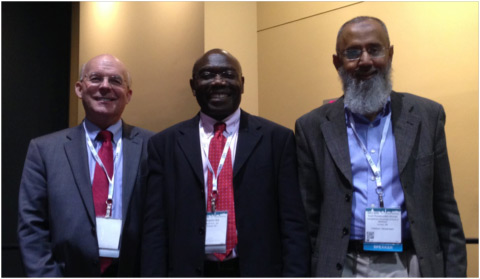
- This event has passed.
FDAAA International Network Featured at 51st Annual DIA Meeting
August 1, 2015
By Ekopimo Ibia, MD, MPH
Over the last decade, there have been widespread activities by nations, nonprofits, and industry to optimize global regulatory capacity, particularly in low and middle-income countries (LMICs). At the 51st Annual DIA meeting recently held in Washington, D.C., FDAAA International Network (FDAAAIN) hosted a session to highlight some of the progress made to date and opportunities for further improvement in global regulatory capacity.
Ekopimo Ibia, MD, MPH, FAAP (Co-Chair of FDAAAIN and Director, Medical Safety Review, Merck & Co., Inc.) chaired the session, titled “Progress Report on Emerging Nations and Regulatory Capacity Building.” Highlights of the session included (a) the evolving effort to establish good reliance practices as an international best practice for a more efficient use of available global regulatory capacities, (b) the commendable progress toward setting up functional Regional Centers of Regulatory Excellence (RCORE) in sub-Sahara Africa, and (b) the recommendation for a systems approach to dealing with the challenges inherent in regulatory optimization efforts.
Former FDAer Dr. Murray (Mac) Lumpkin, MD, MSc (Deputy Director, Regulatory Affairs, Lead Global Regulatory Systems Initiatives, Bill and Melinda Gates Foundation, USA) kicked off the session with a presentation on regulatory systems optimization in LMICs. A major challenge in such countries, he said, is that the pharmaceutical access systems are often “open,” loosely regulated, multifaceted, and complex with insecure supply chains and significant gaps in capacity, leading to long delays in patient access to quality medicines, and resulting in products of uncertain quality, safety, and efficacy being readily available to patients.
Dr. Lumpkin summarized BMGF’s vision and strategy for regulatory system optimization, which aims for a 50% reduction in registration time by 2018, thereby accelerating access to important medicines and vaccines in those countries without sacrificing product safety, efficacy, or quality. An example of BMGF’s multifaceted strategic actions is its support for the African Medicines Regulatory Harmonization (AMRH) initiative currently being undertaken in partnership with the World Bank, World Health Organization (WHO), The New Partnership for Africa’s Development (NEPAD), and others. AMRH program is based on existing regional economic communities and is a regional approach to work sharing and resource leveraging.
Dr. Lumpkin also underscored the need for accelerated local registration of WHO prequalified products through the WHO Collaborative Registration Procedure (CRP). He described the evolving effort to establish good reliance practices throughout the product development and assessment chain as an international best practice for 21st century regulatory authorities, which facilitates a more efficient use of available global regulatory capacities.
Dr. Lumpkin’s presentation provided segue to the next presentation titled “Regional Centres of Regulatory Excellence (RCORE): Innovative Regulatory Workforce Development Initiative in Africa.” Dr. Ibia delivered the presentation on behalf of Mr. Paul Kiptum Tanui, MBA, RPh (Senior Programme Officer, African Medicines Regulatory Harmonisation Programme, NEPAD, South Africa) who could not attend the meeting.
Mr. Tanui summarized the background, eligibility criteria, and the selection process for designation of an institution as a RCORE, a pragmatic initiative of NEPAD Agency to support regulatory workforce capacity development in Africa as articulated in the 2011-2015 Strategic Plan of the AMRH initiative. RCOREs are based on nine core categories of regulatory functions spanning the product lifecycle. RCOREs main mandate is capacity building through technical training and hands-on skills enhancement. As at June 8, 2015, NEPAD had designated eleven RCOREs across sub-Sahara Africa with some RCOREs receiving designation for more than one category of regulatory functions. The designations are for an initial period of four years with eligibility for re-designation based on satisfactory ongoing performance evaluation.
The final presentation was given by Dr. Syed Rizwanuddin Ahmad, MD, MPH, FCP, FISPE, Pharmacovigilance Consultant / Assistant Professor (adjunct), Georgetown University School of Medicine, USA. Speaking on “Strengthening Pharmacovigilance Systems of Emerging Economies: Opportunities and Challenges,” Dr. Ahmad presented a brief overview of the state of pharmacovigilance (PV) system across LMICs (specifically in Asia and Africa) based on the minimum requirements for such a system (e.g., enabling laws, regulations and policies; appropriate structures, systems, and stakeholder coordination; data management and signal detection; risk assessment and evaluation; and risk management and communication).
While significant gaps remain in all the core components of the system in many of those countries, the greatest needs are technical support and equipment, training for long-term capacity building and research, and funding support for sustainability, he said. Dr. Ahmad delineated the roles of the various stakeholders in ensuring a strengthened PV system. Further, he highlighted the many challenges to achieving effective PV systems in LMICs. Finally, he called for a systems approach to dealing with the challenges and implored the international community to seize the opportunity to support sustained strengthening of PV systems in LMICs.
Audience participation was robust with much of the discussion focused on ways to effectively galvanize the various participants in the regulatory optimization activities as well as sustainability of the progress made so far.

L to R: Drs. Murray (Mac) Lumpkin, Ekopimo Ibia, and Rizwan Ahmad
